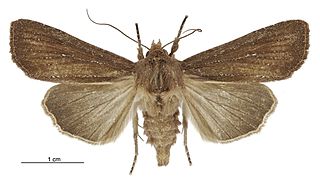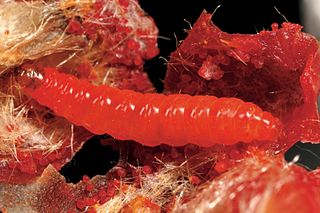Related Research Articles

Hyposmocoma is a genus of moths with more 350 species endemic to the Hawaiian Islands. The genus was first described by Arthur Gardiner Butler in 1881. Most species of Hyposmocoma have plant-based diets, but four species, such as Hyposmocoma molluscivora, eat snails. The caterpillars spin silk, which they then use to capture and eat snails. These are the first caterpillars known to eat snails.

The Plutellidae are a family of moths commonly known as the diamondback moths, named after the diamondback moth of European origin. Some authors consider this family to be a subfamily of the Yponomeutidae, but it is usually considered to be a family in its own right, and have three subfamilies, Plutellinae, Praydinae, and Scythropiinae.
Piletocera is a genus of moths of the family Crambidae. The genus was first described by Julius Lederer in 1863.

Ichneutica is a genus of cutworm or dart moths in the family Noctuidae, found in New Zealand and surrounding islands. There are more than 80 described species in Ichneutica, the largest known genus of Lepidoptera in New Zealand. In 2019 this genus was revised and greatly expanded with the genera Graphania Hampson, 1905, Tmetolophota Hampson, 1905 and Dipaustica Meyrick, 1912 all subsumed within it.

Caloptilia is a genus of moths in the family Gracillariidae.

Xyloryctidae is a family of moths contained within the superfamily Gelechioidea described by Edward Meyrick in 1890. Most genera are found in the Indo-Australian region. While many of these moths are tiny, some members of the family grow to a wingspan of up to 66 mm, making them giants among the micromoths.

Miscera is a genus of moths in the family Brachodidae.

Gracillariinae are a subfamily of moths which was described by Henry Tibbats Stainton in 1854.

Tmetolophota micrastra is a moth of the family Noctuidae. It was described by Edward Meyrick in 1897 from a specimen collected in Wellington and obtained from George Hudson. It is endemic to New Zealand. In 2019 Robert J. B. Hoare published a paper in which he undertook a major review of New Zealand noctuids. Hoare, having inspected the holotype specimen of this species, placed it within the genus Ichneutica.
Sagalassa is a genus of moths in the family Brachodidae.
Miscera basichrysa is a moth in the family Brachodidae. It was described by Oswald Bertram Lower in 1916. It is found in Australia and New Guinea.
Miscera centropis is a moth in the family Brachodidae. It was described by Edward Meyrick in 1907. It is found in Australia.
Miscera holodisca is a moth in the family Brachodidae. It was described by Edward Meyrick in 1907. It is found in Australia.
Miscera isomacha is a moth in the family Brachodidae. It was described by Edward Meyrick in 1925. It is found in Australia.
Miscera leucopis is a moth in the family Brachodidae. It was described by Edward Meyrick in 1907. It is found in Australia.
Miscera omichleutis is a moth in the family Brachodidae. It was described by Edward Meyrick in 1907. It is found in Australia.
Miscera orthaula is a moth in the family Brachodidae. It was described by Edward Meyrick in 1907. It is found in Australia.

Carposina is a genus of moths in the Carposinidae family.
References
- ↑ Savela, Markku, ed. (28 August 2020). "Miscera micrastra Meyrick, 1907". Lepidoptera and Some Other Life Forms. Retrieved 7 September 2020.
| This article relating to moth family Brachodidae is a stub. You can help Wikipedia by expanding it. |